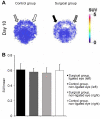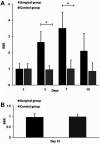In Vivo Imaging of Ischemia/Reperfusion-mediated Aminopeptidase N Expression in Surgical Rat Model Using 68Ga-NOTA-c(NGR)
- PMID: 35241519
- PMCID: PMC8931911
- DOI: 10.21873/invivo.12750
In Vivo Imaging of Ischemia/Reperfusion-mediated Aminopeptidase N Expression in Surgical Rat Model Using 68Ga-NOTA-c(NGR)
Abstract
Background/aim: Previous studies have already shown that 68Gallium(68Ga)-labeled NGR-based radiopharmaceuticals specifically bind to the neoangiogenic molecule Aminopeptidase N (APN/CD13). The aim of this study was to evaluate the applicability of 68Ga-NOTA-c(NGR) in the in vivo detection of the temporal changes of APN/CD13 expression in the diabetic retinopathy rat model using positron emission tomography (PET).
Materials and methods: Ischemia/reperfusion injury was initiated by surgical ligation of the left bulbus oculi of rats. In vivo PET imaging studies were performed after the surgery using 68Ga-NOTA-c(NGR).
Results: Significantly higher 68Ga-NOTA-c(NGR) uptake was observed in the surgically-ligated left bulbus, compared to the bulbus of the non-surgical group at each investigated time point. The western blot and histological analysis confirmed the increased expression of the neo-angiogenic marker APN/CD13.
Conclusion: 68Ga-NOTA-c(NGR) is a suitable radiotracer for the detection of the temporal changes of the ischemia/reperfusion-mediated expression of APN/CD13 in the surgically induced diabetic retinopathy rat model.
Keywords: 68Ga-NOTA-c(NGR); Aminopeptidase N; Angiogenesis; NGR peptide; ischemia/reperfusion; positron emission tomography.
Copyright © 2022, International Institute of Anticancer Research (Dr. George J. Delinasios), All rights reserved.
Conflict of interest statement
The Authors declare no conflicts of interest.
Figures




References
-
- Blair M. Diabetes mellitus review. Urol Nurs. 2016;36(1):27–36. - PubMed
-
- Ribeiro L, Bandello F, Tejerina AN, Vujosevic S, Varano M, Egan C, Sivaprasad S, Menon G, Massin P, Verbraak FD, Lund-Andersen H, Martinez JP, Jürgens I, Smets E, Coriat C, Wiedemann P, Ágoas V, Querques G, Holz FG, Nunes S, Neves C, Cunha-Vaz J, Evicr Net Study Group Characterization of retinal disease progression in a 1-year longitudinal study of eyes with mild nonproliferative retinopathy in diabetes type 2. Invest Ophthalmol Vis Sci. 2015;56(9):5698–5705. doi: 10.1167/iovs.15-16708. - DOI - PubMed
MeSH terms
Substances
LinkOut - more resources
Full Text Sources
Miscellaneous
